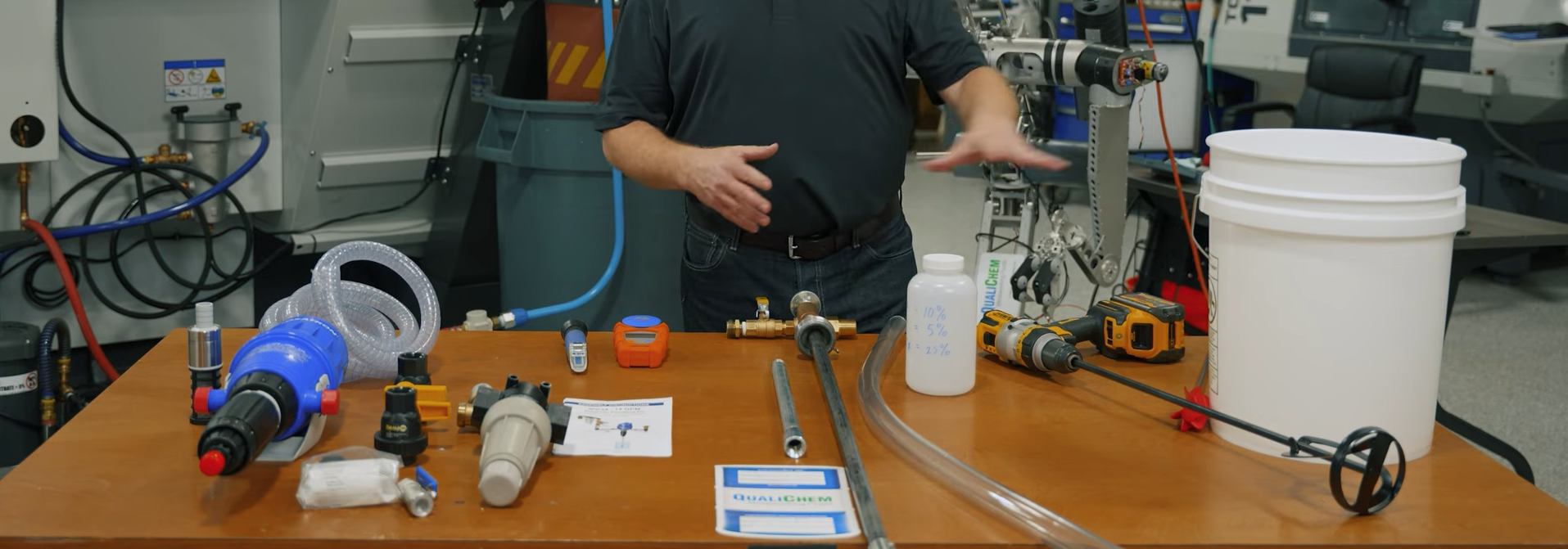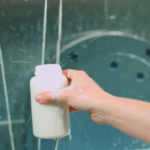
How to Properly Mix a Coolant
Proper mixing of your coolant will optimize its performance and help to avoid potential issues. Let’s discuss three different methods for mixing coolant.
Method 1: Manual Mixing
For smaller shops, the simplest and least expensive way of mixing a coolant is to do it manually. While this method works, we recommend considering the two methods we’ll discuss next for better repeatability and efficiency. When mixing manually, always remember to add concentrate to water and never water into concentrate. OIL: oil in last – is a helpful acronym.
Here are the steps for manual mixing:
- Start with a clean bucket. It’s important to have a clean bucket dedicated to coolant mixing, like a 5-gallon pail.
- Use a dedicated one-quart container. Having a dedicated container helps with the math when measuring ratios. There are 20 quarts in a 5-gallon pail.
- Fill the bucket halfway with water. The empty space in the pail will allow for efficient mixing.
- Add the recommended amount of concentrate. Measure and add the recommended amount of concentrate into the bucket. One quart of concentrate in 19 quarts of water is roughly 5%, and two quarts of concentrate in 18 quarts is roughly 10%.
- Mix thoroughly. We recommend using power tools to mix the concentrate with water efficiently until it’s thoroughly blended.
- Top off with water. Fill the bucket up the rest of the way with water.
- Fill your machine. Once you have your mixed coolant, fill your machine accordingly.
Remember that over time, as water evaporates from your machine’s sump, the concentration of your coolant will increase. To maintain consistency, it’s recommended to replace most of what you’re adding back into your machine sump with a very dilute mixture of coolant. Typically, a 2% top-off will keep the machine at 8%.
Method 2: Venturi-Style Proportioner
If you want to move away from manual mixing, consider using a Venturi-style proportioner like Zebra Skimmers’ Machinist Mixer. This device offers a simple and cost-effective way to mix coolant.
Here’s how it works:
- Connect the water line. Connect the water line to the proportioner.
- Adjust concentration. Use the on-off valve and the knob on the proportioner to control the concentration of the mixture.
- Test coolant with a refractometer. Since the numbers on the dial may not directly correspond to your desired output, it’s important to test the concentration using a refractometer.
The Venturi-style mixers are suitable for companies using a few drums per year. The primary drawback is being prone to variations in concentration output based on variations in available water pressure.
Method 3: Piston-Style Mixer
The most efficient and time-saving method for shops using several drums or more per year is a piston-style mixer like Dosatron’s dosing pump. This type of mixer offers more consistent mixing regardless of water pressure or flow rate.
Here’s how it works:
- Connect and adjust. Per the manufacturer’s instructions, connect the dosing pump to your plumbing system and drum or tote of concentrate. Adjusting the length of the piston stroke is how the concentration is adjusted. Markings can be found on the dosing pump to provide guidance on concentration settings.
- Consider installation kits. Dosatron offers installation kits that include additional components like strainers, flow regulators, and pressure regulators for optimal performance. Installation kits may be necessary for warranty reasons.
Using a piston-style mixer can result in less waste compared to manual or Venturi-style methods, ultimately saving you money in the long run.
Always Verify with a Refractometer
No matter which method you choose, it’s always important to verify the concentration of your coolant using a digital or analog refractometer. This ensures accuracy and helps maintain optimal performance.
Properly mixing your coolant and maintaining it at the correct concentration is crucial for an effective coolant maintenance program. If you have any questions regarding how to properly mix a coolant or need further assistance, contact us today. We’re here to assist you in maximizing the efficiency of your metalworking processes.



